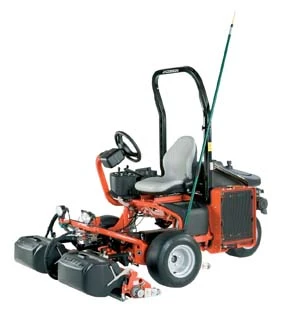
Jacobsen has introduced its Jacobsen GP400 ride-on triplex greens mower and a pair of light fairway mowers to the market
Replacing the popular G-Plex III, the GP400 continues the innovation synonymous with the Jacobsen name. Production began in December 2010 and the first machines are available now.
This new mower retains many of the features of its predecessor including a swing-out center reel for easy maintenance and adjustment and the legendary cutting units with 7, 9 or 11-blade reels. There’s a choice of engines with either a Briggs and Stratton V twin, air cooled gas engine, developing 17.7 hp (13.2kW) at 3400 rpm or a Kubota 3 cylinder diesel engine developing 17.7 hp (13.2kW) at a slightly lower 3200 rpm.
However, the Jacobsen design engineers have introduced numerous improvements to produce a ride-on greens mower that is worthy of the Jacobsen name. A new tank design incorporates the fuel and hydraulic reservoirs in a single molded unit providing better weight distribution and improved stability. As the fuel tank empties it has less effect on the machine’s centre of gravity and a sump in the bottom alleviates fuel starvation on slopes. The tank is hinged and can be lifted to provide much improved access to the engine compartment with a 70% wider opening than on the G-Plex III. A molded impression in the tank is fitted with an elasticized cargo net to provide a carrying facility for clothing.
The control layout and dash has been redesigned to improve ergonomics with more space for the electrical components and therefore easier maintenance. The standard Jacobsen joystick control featuring one-touch lift and lower sits comfortably within the unit, with a factory-fitted optional paddle, mounted on the steering column, available for customers who prefer this form of lift/lower.
The battery cover now allows access to the battery without lifting the seat, is double skinned for added strength and incorporates a small integrated storage tray. An all-new ROPS frame, fully compliant with ISO21299 and pre-drilled to take the optional dew whip holder, is fitted to a strengthened chassis that reduces vibration to the operator. In fact, whole-body vibration has been reduced by 50% and noise exposure at the operator’s ear level has been reduced by 2 dBa. Other factors contributing to reduced noise are the repositioning of the air filter beside the radiator and the addition of louvered panels to the radiator on the diesel model to deflect noise away from the operator.
Operator access and visibility have also been improved with the introduction of a step behind the front wheel and the angle of the curved steering arm has been adjusted to improve the view of the right-hand cutting unit. The steering arm clamp, which enables the arm to be positioned for the optimum comfort of the operator, has been moved for easier adjustment.
From a maintenance perspective, a new valve block design has reduced the number of individual valves, which reduces complication and makes for easier servicing, while reducing the potential for leaks. As stated previously the swing-out center reel allows easy access for changing the height of cut and routine inspection and maintenance. Better access to a much improved engine bay will also be of benefit to equipment technicians and backlapping is now standard on both models.
 The new light fairway mowers designated the LF550 and LF570 are in production and are available now.
The new light fairway mowers designated the LF550 and LF570 are in production and are available now.
Replacing the very popular LF-3400 and LF-3800, these new light fairway mowers retain many of their predecessor’s best features but with additional enhancements that improve functionality and reduce maintenance requirements.
Visually the most striking difference is the restyled hood, which mimics the design of the Jacobsen Eclipse 322 greens mower launched at GIS last year. However, it’s under the skin where the LF550/570 has been improved significantly, again taking its lead from the electronics that have been tried and tested in the Eclipse.
A smooth uptake of power using the ‘drive-by-wire’ operation of the electronically controlled traction pedal is a feature that the greens staff will experience. This helps to prevent wheel spin and the low pedal effort increases operator comfort.
Gone is the parallel series hydraulic drive circuit, which is now replaced with, a cross-parallel system that provides class leading traction on slopes. In the event of a front wheel losing traction, the power (hydraulic fluid) is split and transferred to both rear wheels ensuring that three wheels are operating at all times. This is a feature unique in the turf equipment industry.
A new braking system has been engineered with wet brakes integrated into the front wheel motors. These are maintenance-free and require no adjustment to linkages or cables. A rocker switch on the control arm applies the brakes when the engine is running and the brakes are applied automatically when the engine is turned off. The final feature of the braking system is the electronic hill hold. This applies the brakes automatically after it detects no input from the operator’s foot pedal. The brakes are automatically released when the traction is depressed. This is yet more Eclipse transferable technology.
As stated earlier, it’s under the skin where some of the major, but unseen changes have occurred. Steel tubing has replaced many of the flexible hoses and common hose lengths across the five reels results in fewer service parts. The front reel valve been relocated away from the proximity of direct water spray and the backlap speed control valve is now more accessible. There is now only one proximity switch on the entire machine. All of these improvements reduce maintenance time and the cost of ownership.
The control panel built into the top of the hydraulic oil tank has been replaced with an Eclipse-style armrest control module that moves with the operator’s seat when adjusted. The controls, including factory standard cruise control, are ergonomically placed for operator comfort and an LCD display provides real-time information including engine hours and temperature. If a problem is detected the LCD display provides simple text messages along with a warning alarm to notify the operator of the fault.
For the superintendent and technician there’s a pin-protected maintenance mode which allows numerous functions to be adjusted and set. Maximum mow and travel speeds can be input, the cruise control enabled or disabled and there’s a status screen that checks the functional operation of all electrical switches.
Retained from the previous models are the legendary XP cutting units with 5” diameter cutting units with 7-blade reels and the 7” diameter units fitted with either 9- or 11-blade reels. A Kubota 35.5hp V1505E diesel engine is the standard power unit with an optional 44.2hp turbocharged unit also available.
Due to the introduction of electronic hydro control, it is now possible to have more precise control of frequency of clip (FOC). With the mow speed controllable in increments of 0.2 mph, the FOC can also be controlled accurately; for example, with the 5” diameter, 7-blade reel FOC ranges from 0.444” at 6 mph to 0.592” at 8 mph. With the 7” diameter, 11-blade reel FOC decreases to 0.390” at 6 mph, rising to 0.520” at the maximum mow speed of 8 mph.
A further feature to ensure consistency of cut occurs when the operator engages the PTO switch to run the reels, the mower automatically adopts the set mow speed, thereby maintaining the correct FOC on the fairways.
Finally, there’s a list of accessories that includes verticutting units, turf groomers, powered rear roller brushes, a canopy and MAGsystem.
Latest from Golf Course Industry
- PBI-Gordon promotes Jeff Marvin
- USGA investing $1 million into Western Pennsylvania public golf
- KemperSports taps new strategy EVP
- Audubon International marks Earth Day in growth mode
- Editor’s notebook: Do your part
- Greens with Envy 66: A Southern spring road trip
- GCSAA’s Rounds 4 Research auction begins
- Quali-Pro hires new technical services manager





